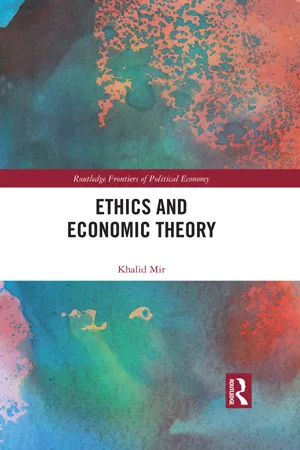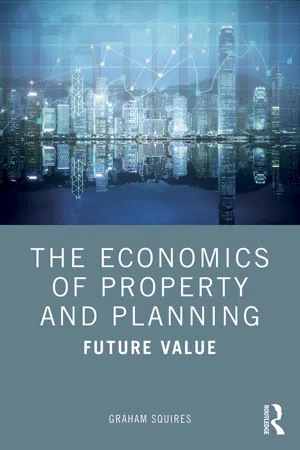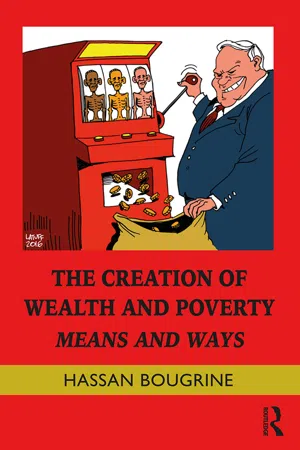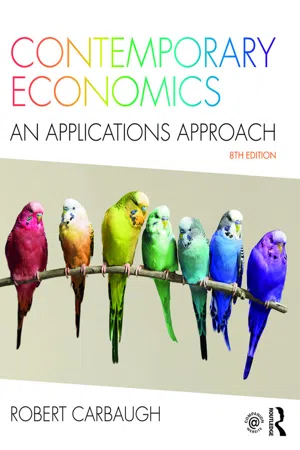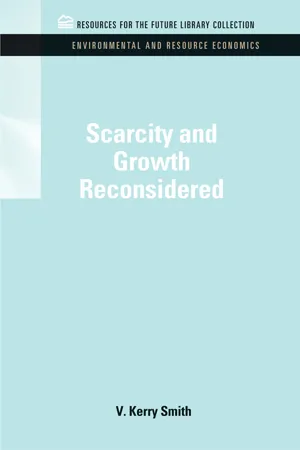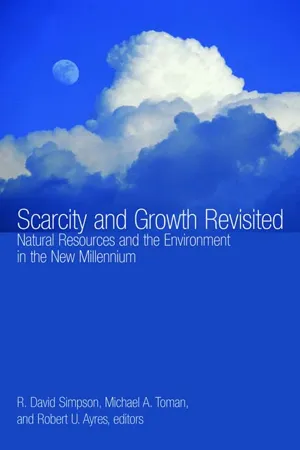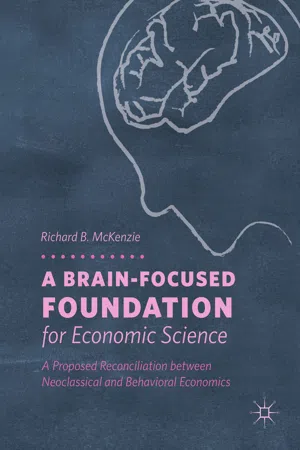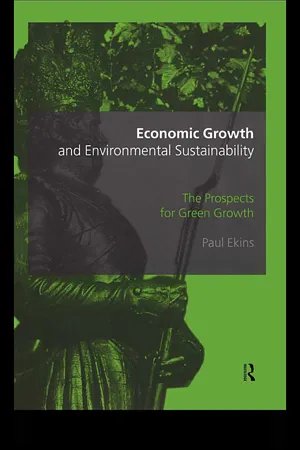Economics
Scarcity
Scarcity refers to the fundamental economic problem of limited resources in the face of unlimited wants and needs. It is the condition where the available resources are insufficient to satisfy all human wants and needs. This concept is central to understanding the allocation of resources and the necessity of making choices in the face of scarcity.
Written by Perlego with AI-assistance
Related key terms
Related key terms
1 of 4
Related key terms
1 of 3
10 Key excerpts on "Scarcity"
- eBook - ePub
- Cynthia Metcalf, Rhonda Atkinson(Authors)
- 2017(Publication Date)
- Research & Education Association(Publisher)
Most contemporary definitions of economics involve the notions of choice and Scarcity and their relationship to one another. Perhaps the earliest of these is by Lionel Robbins in 1935: “Economics is a science which studies human behavior as a relationship between ends and scarce means which have alternative uses.” Virtually all textbooks have definitions that are derived from this definition, though the exact wording differs from author to author.The standard definition of economics is something like this: “Economics is the social science that examines how people choose to use limited or scarce resources to obtain maximum satisfaction of unlimited wants.”Macroeconomics is the study of the economy as a whole and includes topics such as inflation, unemployment, and economic growth. Microeconomics is the study of the individual parts (e.g., households, business firms, and government agencies) that make up the economy. It particularly emphasizes both how these units make decisions and the consequences of these decisions.COMPETENCY 2.1Analyze how Scarcity and opportunity cost influence choices about how to allocate resources.Economists believe that human wants are unlimited while the resources to satisfy those needs are limited. Consequently, society is never able to produce enough goods and services to satisfy everybody, or almost anyone, completely. Alternatively, resources are scarce relative to human needs and desires. When resources are limited, the limitation affects prices (the amount of money needed to buy goods, services, or resources). Scarcity - eBook - ePub
- Khalid Mir(Author)
- 2018(Publication Date)
- Routledge(Publisher)
1Needs and ScarcityScarcity means that society has limited resources and therefore cannot produce all the goods and services people wish to have. (Mankiw and Taylor, 2011, p. 2)The real world has its limits; the imaginary one is infinite. (Rousseau cited in Nazar, 2018, The Eyes of Others: Rousseau and Adam Smith on Judgment and Autonomy)Hell hath no limits. (as cited in Berry, 2008)1.0 Introduction
The bedrock of economic theory rests on three assumptions: economic agents are rational, self-interested individuals. In later chapters I will critique each of those three inter-related and structuring assumptions. One of the central premises of this book is that we often ignore, at our own peril, the fact that assumptions used in an academic discipline originate in a particular historical context and that our assumptions about human behaviour (motivations and ‘ends’) may not, therefore, have universal validity. The deployment of “universal categories without reference to time, place or context” (Milonakis and Fine, 2009, p. 3) is itself a historical phenomenon that calls for an explanation of both the trajectory of society and, parallel to it, the development of economic theory.A second and related theme that runs throughout the book is the idea that the picture we form of ourselves (in this case : homo economicus ) can have a profound influence on both our sense of identity and our relation to other people, time and the natural habitat. And because we can grow into the picture we form of ourselves we may fail to acknowledge how a picture of reality can change the way in which we relate to both other people and the world. Our structuring assumptions then go unquestioned because our behaviour has become consistent with them.In this chapter I examine the idea of Scarcity because it is profoundly intertwined with the idea that we are rational, self-interested individuals. Scarcity is so central to our understanding of the economics discipline that it stands to define the economic point of view itself. - eBook - ePub
The Economics of Property and Planning
Future Value
- Graham Squires(Author)
- 2021(Publication Date)
- Routledge(Publisher)
With regard to for ‘whom’ these goods and services are realised and by which method, different social groupings may benefit or lose depending on particular social cleavages such as wealth and class (lower, middle, upper, under), race, religion, gender, age, and sexuality. Particular minorities and majorities will benefit from the choices made in society – including private decisions by for instance commercial property interests and public interests such as politicians seeking the best combination of public returns for their constituents. Different goods (e.g. the production of merit goods such as education) and how they are produced (e.g. public, private, or a combination) will affect who ultimately receives the good or service. As an example, not all schoolchildren will be able to afford private education and would not be able to receive education.So more broadly, economics is the study of how society decides what, how, and for whom to produce. It is the decisions made by society that are of importance in determining the three questions of what, how, and for whom to produce – and these decisions can often be influenced by the level of ‘wants’ and ‘resources’ available.Resources, wants, and Scarcity
At either end of the spectrum in which wants and resources are situated is the idea of ‘Infinite Wants’ on one end, and ‘Scarce Resources’ on the other. Infinite wants hold the notion that people are hard-wired to always want to consume more goods, services, and experiences. Scarce resources in the form of factors of production (Land, Labour, Capital, and Entrepreneurship) restrict the ability for all of these infinite wants to be satisfied completely – as Scarcity defines the resources as having limited availability. Due to this mismatch of infinite wants and scarce resources, it is thought in economic terms that a choice will need to be made.Using a property and planning example, a situation can be described where residents will want to live in a property that allows an improved quality of life – such as whether that is a better location, better school catchment, areas with low crime, commutable to suitable employment, and near to recreation space. However, these wants are curtailed due to the Scarcity of resources, for instance, there is only finite (or even unique) land available for desirable locations, there are a limited number of available schools, not all locations are crime (or fear of crime) free, the commute time to work will have a limit, and there is only a finite amount of land available for recreation. As a result, this housing example demonstrates that the wants will not be completely satisfied given the scarce resources (and factors of production), and a compromise and choice will have to be made. This idea of choice can be aggregated to a national scale and demonstrate that not all of a nation’s inhabitants will be satisfied. - eBook - ePub
The Creation of Wealth and Poverty
Means and Ways
- Hassan Bougrine(Author)
- 2016(Publication Date)
- Routledge(Publisher)
unlimited wants” – thus reducing humanity’s ‘economic problem’ to one of “Scarcity”. In short, Scarcity is the basis of the entire neoclassical system of thought. The problem, however, is that the existence of Scarcity is always assumed but never proved. Whether we are dealing with the trivial issue of satisfying the appetite of a gluttonous man or with a more fundamental question such as the need for financing for the construction of a school or a hospital, neoclassical economists are quick to put forth the argument of a binding constraint of Scarcity – either of food or of money. The Scarcity of money, as it turns out, is the overarching argument used to justify all the ills in society. It justifies hunger and malnutrition, homelessness, illiteracy and all other manifestations of poverty.At the microeconomic level, it is understandable and even tautological to say that a person is poor because they do not have a lot of money – and that, for objective reasons, they cannot get more of it no matter how hard they try. Workers just cannot stretch their wages to make them grow higher (unless they get a pay raise) and the poorer ones cannot even stretch their wages enough to make them last until the next payday. Many of the working poor end up falling further into poverty as they resort to payday loans, rent-to-own and so on for which they pay usury interest rates and higher prices through installments and fees. In her book, The Cost of Being Poor, Barnes (2005) summarizes some of the additional economic and noneconomic costs faced by the poor. From our perspective, this is the problem of unequal distribution of income and wealth, which we dealt with in the previous three Chapters.At the macroeconomic level, however, the notion of Scarcity of money is much more problematic for several reasons, the most important of which is the fundamental difference between the national government and private citizens, be they firms or households, as regards access to money. While households and firms are recipients and end-users of that which we call money, the national government, through its Central Bank, is its issuer, its creator - No longer available |Learn more
Contemporary Economics
An Applications Approach
- Robert Carbaugh(Author)
- 2016(Publication Date)
- Routledge(Publisher)
Normative economics involves value judgments that cannot be tested empirically. Ethical standards and norms of fairness underlie normative economics. For example, should the United States penalize India for violating U.S. patent and copyright laws? Should welfare payments be reduced in order to encourage the unemployed to find income-producing jobs? Should all Americans have equal access to health care? Because these questions involve value judgments instead of facts, there are no right or wrong answers. Both positive and normative economics are important and will be considered throughout this textbook.Why do economists often appear to give conflicting advice to policymakers? Because economists do not fully understand how the economy operates, they often disagree about actual cause-and-effect relationships. Moreover, economists may have different value judgments, and thus different normative views, about the goals that economic policies should attempt to accomplish.The first part of this chapter has given us an overview of economics and the economic way of thinking. We will now examine the economic problem of Scarcity.Scarcity
Whether you are taking just one economics course or majoring in economics, the most important topic you will learn about is Scarcity. Scarcity means that there are not enough, nor can there ever be enough, goods and services to satisfy the wants and needs of everyone. Consider your own situation. Can you afford the school that you would most prefer to attend or the car that you would most like to own? Do you have sufficient financial resources for all the clothes, computers, concerts, and sporting events that you want? Societies also face a Scarcity problem. Money devoted to national defense, for example, is not available for education or food stamps.The source of the Scarcity problem is that people have limited resources to satisfy their unlimited material wants. Resources, or factors of production - eBook - ePub
- V. Kerry Smith(Author)
- 2013(Publication Date)
- RFF Press(Publisher)
10 Measures of Natural Resource ScarcityAnthony C. Fisher I am grateful to Bengt Hansson, Geoffrey Heal, Alvin Klevonck, Harvey Lapan, and Karl-Göran Mäler for helpful discussions and comments on an earlier draft.I Introduction: Physical and Economic Scarcity
The widely publicized predictions of impending Scarcity and even exhaustion of extractive natural resources such as metals and fuels, in the Club of Rome study The Limits to Growth, and the less widely publicized rebuttals (see, for example, Beckerman [1], Nordhaus [2], and Kay and Mirrlees [3]) suggest that a careful analysis of what is meant by resource Scarcity, and of how it is measured or indicated, might be worthwhile. This paper is intended to provide such an analysis. Specifically, in this section I consider the meaning of Scarcity, and in subsequent sections a number of proposed measures, their properties, and their behavior as a resource stock is depleted or augmented over time.Perhaps the question, "What is Scarcity?" is too simple for economists, or at any rate, too simple to be made explicit. We ordinarily say a good—or a resource—is scarce if the quantity demanded exceeds the quantity supplied at some benchmark price, such as the prevailing one, so that in a competitive market there is an upward pressure on the price. As a special case, goods are sometimes considered scarce, or "economic," as opposed to "free," if this excess demand is positive at a zero price. But much of the current debate about natural resource Scarcity focuses on physical measures, such as the stock of reserves. To obtain some idea of the economic implications of an estimated reserve base, it is typically compared with another physical quantity, projected consumption, giving rise to conclusions on how many years' worth of coal, or iron, or whatever is left at current or projected rates of consumption.1 - eBook - ePub
Scarcity and Growth Revisited
Natural Resources and the Environment in the New Millenium
- R. David Professor Simpson, Michael A. Professor Toman, Robert U. Professor Ayres(Authors)
- 2012(Publication Date)
- Routledge(Publisher)
CHAPTER 3
Economics of Scarcity
The State of the Debate Jeffrey A. KrautkraemerW HETHER ECONOMIC growth can be sustained in a finite natural world is one of the earliest and most enduring questions in economic literature. In essence, the issue is whether technological progress and capital accumulation can overcome diminishing marginal returns to finite natural resources. The debate began with the birth of economics as a separate discipline and continues to this day. Its intellectual roots still play a prominent and significant role. It is the topic of the two previous volumes on Scarcity and growth published by Resources for the Future. While the general nature of the debate is unchanged, the focus and topics of discussion have evolved.The past two centuries have seen unprecedented growth in human population and economic well-being for a good portion of the world. This growth has been fed by equally unprecedented natural resource consumption and environmental impacts, including conversion of large portions of the natural world to human use, which have prompted recurring concern about whether the world's natural resource base is capable of sustaining such growth. To some degree, this concern is supported by simple mathematics: exponential physical growth in a finite world eventually generates absurd results. For example, any positive population growth rate eventually has the population completely covering the face of the earth and expanding rapidly into space; any positive growth rate for petroleum consumption eventually results in annual production that is greater than the mass of the earth.While exponential growth can be expected to lead to increasing resource Scarcity human creativity can ameliorate increased Scarcity. Humans have been quite adept at finding solutions to the problem of scarce natural resources: finding more abundant substitutes for various natural resources, exploration for and discovery of new reserves, recovery and recycling of materials, and, perhaps most importantly, the development of new technologies that economize on scarce natural resources or that allow the use of resources that were previously uneconomical. - eBook - ePub
A Brain-Focused Foundation for Economic Science
A Proposed Reconciliation between Neoclassical and Behavioral Economics
- Richard B. McKenzie(Author)
- 2018(Publication Date)
- Palgrave Macmillan(Publisher)
All Robbins insists is necessary for Scarcity to be prevalent is for the “given ends” to exceed the “given means,” or that not all ends can be satisfied (emphasis in the original). 35 He doesn’t hang his concept of Scarcity on the notion that ends, or wants, need to come close to being unlimited, as any number of modern economists seem to do (at least as represented by undergraduate textbooks). For Robbins, a key ingredient to economic Scarcity was the introduction of human evaluation. Quantities of goods and resources considered apart from their evaluation by people may be meaningful to disciplines such as accounting and engineering, but have no meaning for economists’ analytical interests. Even then, marginal evaluations of goods will not be positive without the quantity demanded exceeding the quantity that is available, or can be made available. 36 This suggests that for Robbins, opportunity cost is not merely what is given up in choices. Rather, it is the value of what is foregone in choices. Choices must be made based on some common denominator, which necessarily involves subjective evaluations of options subject to choice (a point that suggests he recognized that options far removed from being viable options would not be given separate evaluations, contrary to what is often presumed in modern choice theory). For Robbins, absolute Scarcity was of no (or maybe of little) consequence to economists. Absolute Scarcity had no more meaning than absolute distance or absolute speed, meaning without their consideration being a matter of relationships with other distances and speeds. What was important, and meaningful, in economic analysis was relative Scarcity, or how scarce something was relative to the Scarcity of other things, which showed up in “relative valuation” and relative prices - eBook - ePub
A Beautiful Constraint
How To Transform Your Limitations Into Advantages, and Why It's Everyone's Business
- Adam Morgan, Mark Barden(Authors)
- 2015(Publication Date)
- Wiley(Publisher)
Chapter 9 Scarcity AND ABUNDANCE Why this capability is so important to all of us todayTHIS CHAPTER FOCUSES ON:
- Will the future be characterized more by Scarcity or abundance?
- Why will constraint-driven problem solving be an inevitable part of the future?
- Why is it so important to develop this capability more broadly and not just leave it in the hands of a chosen few?
These are, to echo Dickens, the best of times and the worst of times.On the one hand, Scarcity is, for good reason, at the top of many political and business agendas. The pressures of an increasing population and developing economies on finite or diminishing resources have led some to dub this the Age of Scarcity.1 While the field of economics has long been said to be, at its heart, the science of Scarcity, the very real constraints the world needs to address give this a new emphasis. Indeed, they are largely constraints to which we are already too slow to respond (if they can be solved at all). As such, they threaten to become the definers of individual, national, and global progress—or regression—for the next twenty years.Abundance, on the other hand, is a post-Scarcity mindset that some suggest is now within reach. Abundance is about multiplying opportunity and ambition with new capabilities emerging today, such as the immense power of technology, and the global networks increasingly connecting people and ideas. You may have experienced this yourself, in ways big and small—faster transactions enabled by massive computing power, or a wealth of insights from the far-flung corners of your organization, like PHD's Source, for instance. The Age of Abundance insists on grounds for optimism, and the possibility of more for everyone. We are, they say, looking at this the wrong way round. - eBook - ePub
Economic Growth and Environmental Sustainability
The Prospects for Green Growth
- Paul Ekins(Author)
- 2002(Publication Date)
- Routledge(Publisher)
in situ price, of zero. Economic agents would not bother to hold it at all. This being so, it is to be expected that the increasing Scarcity of an exhaustible resource, without a perfect, less scarce, substitute, would cause its rent and market price to rise, whether or not the increasing Scarcity resulted in an increase in extraction costs. The rise in price would encourage both the economisation of the use of the resource and the development of substitutes, thereby mitigating the increasing Scarcity. However, while it may be acknowledged, with Dasgupta and Heal (1974:4), that: ‘This argument clearly has force’, their qualification is equally valid: ‘In the absence of a well-articulated temporal plan, or a satisfactory set of forward markets, it is not at all plain that market prices will be providing the correct signals’, as far as an increase in Scarcity or otherwise is concerned.There has been a sustained effort over the last thirty years to test the hypothesis of increasing Scarcity by analysing the movement of resource prices, beginning with Barnett and Morse’s classic (1963) investigation, which, using a unit cost indicator, found no increase in Scarcity since the late nineteenth century over a wide range of resources, with the exception of forest products. Barnett (1979) updated this work and came to the same conclusion. Hall and Hall (1984) found in contrast that coal increased in Scarcity on a unit cost test, but on a relative price test oil, gas, electricity and timber all exhibited Scarcity increases through the 1970s.In the same volume reporting Barnett’s updated results, Brown and Field (1979) present compelling arguments why both unit cost (the Barnett and Morse measure) and product price are ambiguous measures of Scarcity. In contrast: ‘A rising rental rate always portends increasing Scarcity and eventual exhaustion, unless there is a “backstop technology”’ (Brown and Field 1979:235). Unfortunately they also note that rental rates for most resources are not readily available. Furthermore, in the same volume Fisher presents a model in which ‘rent as an indicator of Scarcity has the disturbing property of sometimes decreasing as the resource-stock decreases’ (Fisher 1979:256). Such considerations, theoretical and empirical, suggest that Barnett and Morse’s reassuring (1963) conclusions, and Barnett’s (1979) restatement of them, should be treated with a great deal of caution.
Index pages curate the most relevant extracts from our library of academic textbooks. They’ve been created using an in-house natural language model (NLM), each adding context and meaning to key research topics.
Explore more topic indexes
Explore more topic indexes
1 of 6
Explore more topic indexes
1 of 4

